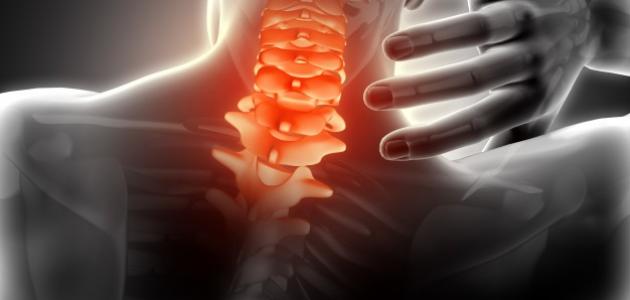Contents
Neck disc
The neck contains seven consecutive vertebrae that make up the first part of the spine , and each vertebrae is separated by a flexible disc that absorbs shocks, and gives the neck flexibility and ability to withstand stresses and loads, as one disc consists of a strong outer layer due to its containing collagen fibers and is called the fibrous ring , and an inner layer that contains a gel of mucous protein , called the nucleus pulposus, and the tablets need to be well moist in order to maintain their strength and work by absorbing shock. But with age, the discs gradually lose their moisture, harden, become less elastic, and worn out, which leads to the exit of the inner layer of the disc, and this in turn causes its contact with the spinal nerve root , and so-calledHerniated cervical disc, which is known among the general population as the neck disc . [1] [2]
Neck disc symptoms
The symptoms of a disc neck vary from one person to another, and when the symptoms begin to appear, the pain develops either slowly over time or it may appear suddenly, and in fact the symptoms range in severity, and the following is a breakdown of these symptoms: [3]
The most common symptoms
There are some symptoms that commonly appear in the event of a neck disc injury, including the following: [3]
- Neck pain: Minor pain caused by stiff neck is the most common symptom, and the pain may start out simple, but its frequency may increase and become severe, and may last for a few hours or days.
- Nerve pain: This type of pain tends to be sharp or similar to electric shock, and the patient feels it below the shoulder and may extend to the arm, hand, or fingers, and it should be noted that the patient usually feels nerve pain on one side of the body.
- Pain that worsens with movement: The pain caused by the disc neck is characterized by its worsening when moving, and improvement after rest.
- Neurological symptoms: The patient feels pain that resembles needle or staples, numbness , and weakness that moves down the shoulder towards the arm, hand, and fingers, and these symptoms can affect the patient's ability to practice daily activities, such as writing, wearing clothes, and carrying things.
Less common symptoms
The more the herniated disc in the neck progresses, the greater the chance of narrowing the spinal canal, or what is known as the spinal canal .
- Difficulty moving the limbs , disorders of the ability to coordinate movement and balance.
- Loss of bowel or bladder control.
- Weakness or numbness anywhere under the neck.
- Electric shock-like pain in the arms or legs, which may worsen when bending forward.
Risk factors
There are some factors that increase the risk of developing a neck disc, including: [4]
- Adopting an unhealthy lifestyle: Smoking, lack of regular exercise , and failure to eat proper and sufficient food speeds up the weakening of the intervertebral disc and its wear.
- Improper lifting or twisting.
- Aging: As aging can lead to biochemical changes that make the tablet lose its elasticity and vitality, and gradually dry it out.
- Poor posture and wrong body movements that increase pressure on the cervical vertebrae.
- Worn and rupture of the neck discs due to injuries.
Stages of disc neck
There are four stages of the occurrence of a neck disc, the following are explained: [4]
- Disk degeneration: Chemical changes associated with aging contribute to weakening the disc, which causes it to dry out and make it less able to absorb shock , and it may also become thinner.
- Disk prolapse: The disc changes shape or location so that it collides with the nerves in the spinal canal, and this stage is also called the bulging disc .
- Disk extrusion: , the pulpy nucleus that represents the inner part of the disk penetrates the outer part, ie the fibrous annulus, but remains inside the disk.
- Disc separation: , and at this stage the pulpy nucleus separates from the fibrous ring completely and may move outside the intervertebral disc towards the spinal canal.
Diagnosis of disc neck
The specialist doctor diagnoses a disc injury by doing the following: [3]
- Medical history: The doctor reviews the patient’s health history and identifies the symptoms he is suffering from.
- Physical examination: in which the doctor performs a physical examination of the patient by examining the range of motion of the neck, where he asks the patient to make certain movements and tell him if the pain increases or decreases.
- Imaging: An MRI , X-ray, or CT scan may be done to verify the diagnosis, and imaging also helps identify other conditions that may be causing symptoms.
Neck disc treatment
Neck disc can be treated with the following treatment options: [5]
- Pain-relieving drugs: such as acetaminophen and non-steroidal anti-inflammatory drugs such as ibuprofen and naproxen may help reduce pain and inflammation. If these drugs do not help in relieving pain, the doctor may resort to steroid drugs or narcotic drugs .
- Physical therapy: Physical therapy is a possible option in cases of neck disc because of its role in helping to improve the range of motion , and providing advice to the injured about the nature of exercises and correct postures.
- Surgery: If the neck pain does not improve after the use of analgesic drugs and physiotherapy, and if the patient suffers from significant numbness or weakness, then surgery may become necessary, and discectomy surgery, which is the main surgery to treat the neck disc, can be performed. In it, the surgeon removes the damaged disc, and is usually followed by placing a metal industrial disc in place of the damaged disc, and as another option the disc removal surgery can be followed by a cervical fusion, during which a small piece of bone is implanted in the space between the two vertebrae to eventually merge with The upper and lower vertebrae.
References
- ↑ "Anatomy of the Human Spine" , www.mayfieldclinic.com , Retrieved 23-1-2018. Edited.
- ↑ "Cervical Discs" , www.spine-health.com , Retrieved 23-1-2018. Edited.
- ^ A b T w "Cervical degenerative Disc Disease And the Symptoms Diagnosis" , Www.spine-health.com , Retrieved 23-1-2018. Edited.
- ^ A b "Cervical Herniated Disc Or Ruptured Disc" , Www.spineuniverse.com , Retrieved 23-1-2018. Edited.
- ↑ "Cervical Disc Disease and Neck Pain" , www.webmd.com , Retrieved 23-132018. Edited.

